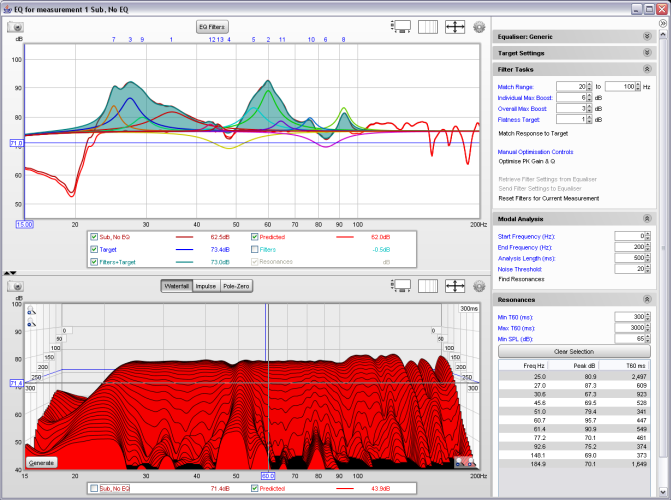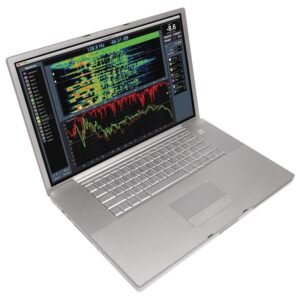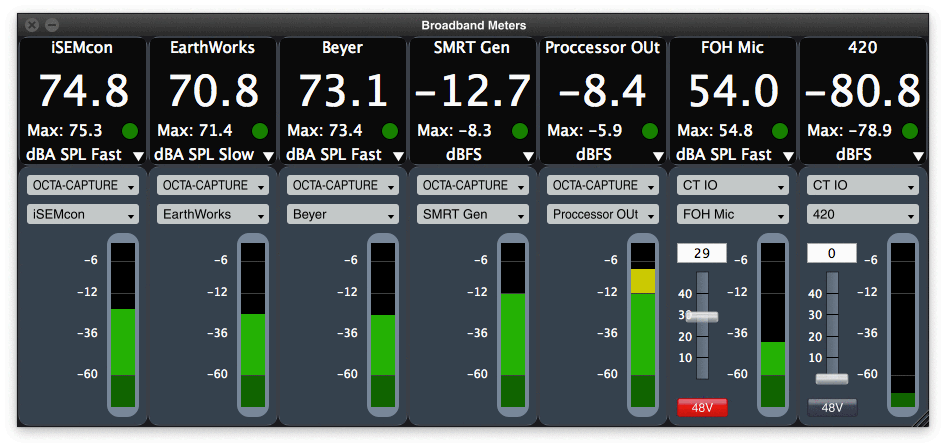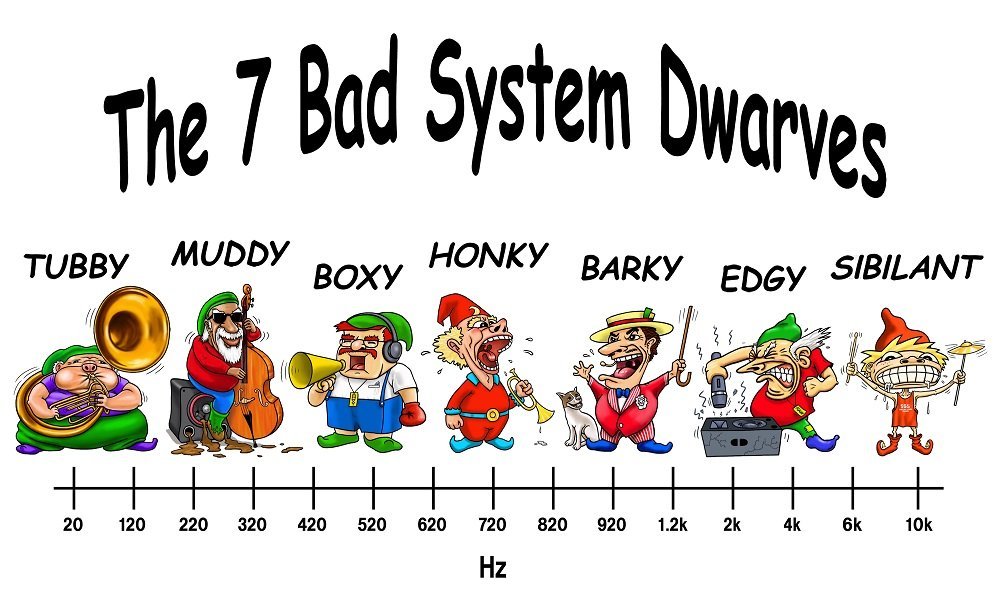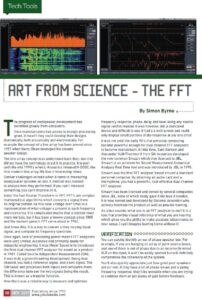News
16 Nov 2017
Art From Science: The FFT
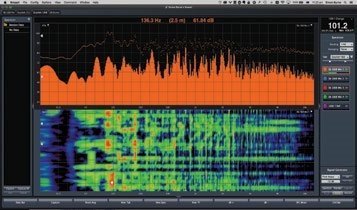
Subscribe to CX E-News
Tech Tools
Art From Science: The FFT
By Simon Byrne.
The progress of loudspeaker development has benefited greatly from computers. Once manufacturers had access to enough processing grunt, it meant they could develop their designs dramatically, both acoustically and electronically.
For example, the concept of a line array has been around since 1957 when Harry Olsen developed his column speaker design. The line array concept was understood back then, but they did not have the technology to put it in practice. It wasn’t until the mid 1990’s when L-Acoustics released V-DOSC, the first modern line array.
We live in interesting times. Similar challenges existed when it came to measuring loudspeaker systems on site. A method was needed to analyse how they performed. If you can’t measure something, you can’t improve on it.
Enter the fast Fourier transform or FFT.
FFT’s are complex mathematical algorithms which converts a signal from its original domain (in this case, voltage over time) to a representation of what voltage is present at each frequency and vice versa. It is complicated maths that is beyond most mere mortals, but it has been a known concept since 1805 and the modern generic FFT came about in 1965.
Just know this, it is a way to convert a time varying input signal, and compute its frequency spectrum.
Once again, lack of processing power mean’t FFT analysers were very limited, expensive and primarily made for industrial engineering. It was Meyer Sound who introduced the first dual channel FFT analyser for sound as a product in 1987. Called Source Independent Measurement (SIM), it was truly a groundbreaking development. Being dual channel, you had a reference signal, and a test signal. The SIM takes and processes both inputs and compares them, the difference between the two signals being the result. This is known as a transfer function.
Now there was a reliable way to measure and optimise frequency response, phase, delay and level using any source signal (within reason). It was however, still a dedicated device and difficult to use. It had a 4 inch screen and could only display small portions of the response at any one time!
It was not until the early 90’s that personal computing became powerful enough for dual channel FFT analysers to become mainstream. At this time, Sam Berkow and Alexander Yuill-Thornton II from SIA Acoustics developed the now common Smaart which they licenced to JBL. Smaart is an acronym for Sound Measurement Acoustical Analysis Real Time tool and was introduced by JBL in 1995.
Smaart was the first FFT analyser based around a standard personal computer. By attaching an audio card and a microphone, you had a powerful, cost effective dual channel FFT analyser. Smaart has been licensed and owned by several companies since JBL, none of which really gave it the love it needed. It is now owned and developed by Rational Acoustics who actively maintain the product as well as provide training.
As a live soundo, what use is an FFT analyser to me? It is a tool that provides visual reference of what you are hearing which gives you the ability to make accurate adjustments to your setup. I can’t imagine leaving home without it!
VERIFICATION
You can quickly identify an out of phase speaker box. For example, if you are hanging an array of point source boxes, and one of them is out of phase due to an incorrectly wired XLR on the input, it won’t be easily spotted but will definitely compromise the coherence of the system.
You’ll also quickly appreciate just how good your speakers are (or not). If they have a lot of phase issues and a peaky frequency response, they’ll be unstable when you are trying to combine them or get plenty of gain before feedback.
ALIGNMENT
Using the impulse response and phase functions, you can adjust timing of the main speakers, and say some delay speakers so that their arrival time is the same at a particular point. This is crucial for increasing intelligibility and reducing echo.
CROSSOVER
Both in frequency and timing. With FFT, you can smoothly observe transition between say the subs and the tops boxes. The subs may be forward of the main PA so they would need to be delayed. In addition, there is likely to be a build up in the low mid frequencies which can be addressed.
RELECTIONS
You might not be able to do too much about room reflections, but at least you can see what is going on.
And frequency response – notice how I mentioned this last? Frequency response tends to be an artistic pursuit so in my view, FFT helps with the process by displaying the frequency response of the system, but you have to be careful not to be a slave to it.
Since we gained the ability to visually represent how something is set, we can pay too much attention to it and not listen to the result. Dual channel FFT however does have a big advantage in that you can see if a dip in frequency response is due to phase problems which may or may not be able to be fixed, or due to the frequency response of the source, which usually can be fixed with equalisation. With single channel FFTs you can see the dip, but don’t necessarily know if it is because of a phase problem.
Real Time Analysis – During the show, you can switch to RTA mode which gives you a quick and dirty display. This is useful for quickly identifying a feedback frequency, or monitoring overall level.
WHAT YOU NEED
You need a decent omnidirectional microphone designed for measurement purposes. Here is a dirty little secret, most of the capsules in low to mid range microphones are the same capsule made by Panasonic. When Panasonic make a batch they test for tolerances and the bad ones are sold really cheaply and of course end up in cheap measurement microphones. The mid range capsules attract a higher price so end up in mid range microphones and so on.
But here is the thing, we are not doing laboratory grade measurements that require the highest of quality microphones. We just need decent quality and even with the poorest of quality microphones, you can still do perfect timing adjustments as well as identify phase issues.
I’ve got a nice $1,000 Earthworks M30 Measurement microphone. But rather than risk damaging or losing it on a gig, it stays at home and I bring some of my $320 Isemcon EMX-7150’s instead. They are nearly as good so I get the same results within +/- 1Db.
AUDIO INTERFACE
Pretty much anything with 2 inputs, 2 outputs and phantom power will get you started. In 2017, frequency response should be flat on most equipment so as long as you get your test signals well above the noise floor, you’ll be fine.
SOFTWARE
Smaart is easily the industry standard. They offer a DI version which is the entry level product, as well as a multi channel version. Satlive is another Windows based product which is slightly cheaper which may be worthwhile checking out. Both of the above have trial versions. If you want to play with a free single channel FFT, download Room Eq Wizard. It is a surprisingly powerful single channel FFT analyser. Designed for home and studio use, it is still very usable in a live sound environment.
There is one BIG caveat with these tools. They are not a substitute to listening. I’ve seen ruler flat frequency response plots that sound terrible in the room. You are there to produce a pleasing sound, not pleasing pictures on your FFT screen so listen first, and verify.
Training is invaluable when it comes to working with these analysers. They are a complex and sophisticated tool that generates a lot of information. Without training, it is hard to fully interpret the data and make the right decisions. I have done 5 days training Smaart with Rational Acoustics in the US, and another 3 days on system optimisation with Bob McCarthy from Meyer Sound, I’m still learning. PAVT conduct training classes in Australia for Smaart.
By the way, don’t take your nice pointy measurement microphones as carry one luggage when flying, airport security think they can be used as a weapon! I once was refused entry into an airport and they wanted me to surrender the microphone. Fortunately I was able to check it in with a friend’s luggage.
USEFUL LINKS
Satlive
Windows Dual Channel FFT
www.satlive.audio/en
Rational Acoustics
Smaart Dual channel FFT for both Windows and Mac Os. Industry standard.
www.rationalacoustics.com/smaart/about-smaart
Room EQ Wizard
Free single channel FFT analyser for Windows and Mac. Seriously good to play around with:
www.roomeqwizard.com
This article first appeared in the print edition of CX Magazine November 2017, pp.51-52.
CX Magazine is Australia and New Zealand’s only publication dedicated to entertainment technology news and issues since 1991. Read all editions for free or search our archive for stories, people, tech-tips, products and production reviews www.cxnetwork.com.au
See also “Spatial Pursuits: The Evolution of Large-Scale Sound System Optimization” by Bob McCarthy, Director of System Optimization, Meyer Sound, April 5, 2017, from ProSoundWeb.com bit.ly/2ADypvk
Subscribe
Published monthly since 1991, our famous AV industry magazine is free for download or pay for print. Subscribers also receive CX News, our free weekly email with the latest industry news and jobs.

